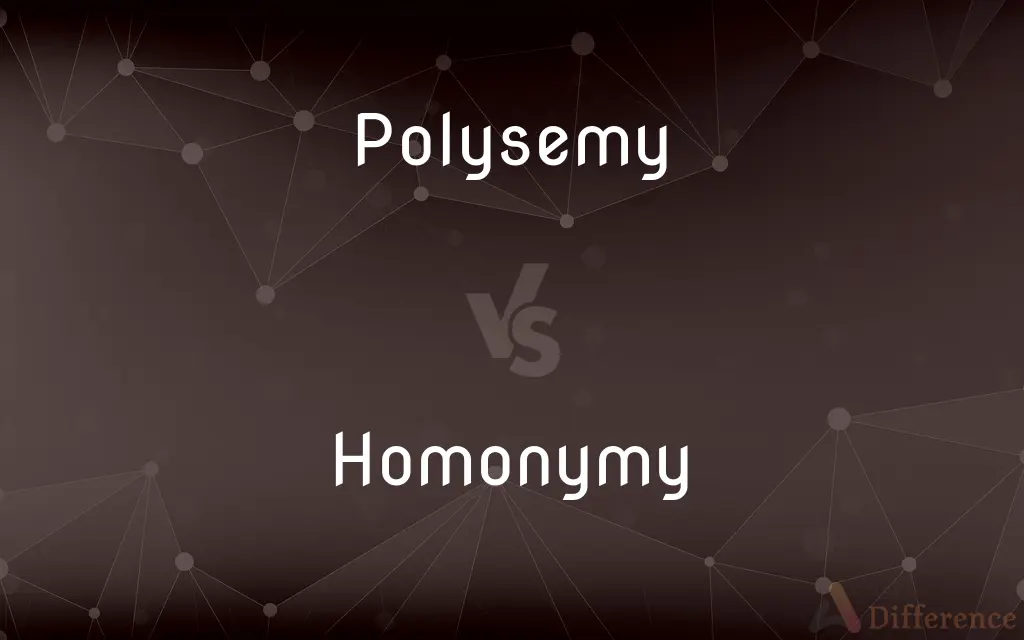Polysemy vs. Homonymy — What's the Difference?
By Tayyaba Rehman — Published on October 12, 2023
Polysemy refers to a single word having multiple related meanings, while Homonymy describes distinct words that sound or look the same but have different meanings.

Difference Between Polysemy and Homonymy
Table of Contents
ADVERTISEMENT
Key Differences
Polysemy and Homonymy are two linguistic terms that address the phenomenon of words having multiple meanings. Polysemy involves one word that possesses several related meanings. For instance, the word "bank" can refer to a financial institution or the side of a river. These meanings, while distinct, share a semantic relation. On the other hand, Homonymy encompasses words that share the same form (in spelling or pronunciation) but have unrelated meanings. An example would be "bat," which can mean a flying mammal or a tool used in baseball.
At its core, Polysemy is about the nuanced shades of meaning a single word can acquire over time, often due to metaphorical extensions. The word "head," for example, can refer to the top part of a body, the front of a line, or the leader of a group. All these meanings are interconnected. In contrast, Homonymy emerges when two entirely different words accidentally end up having the same form. This can be due to linguistic evolution or pure coincidence.
A significant factor to consider is the origin of the multiple meanings. With Polysemy, the various senses of a word usually evolve from a single source, diverging over time. Homonymy, however, results from different words coincidentally converging to have the same form. The distinction is vital for lexicographers, as understanding the relation or lack thereof between meanings can aid in dictionary construction and semantic analysis.
Lastly, while both Polysemy and Homonymy deal with words that have multiple meanings, their implications in linguistics are different. Recognizing Polysemy aids in understanding semantic shifts and cultural metaphors, while identifying Homonymy is crucial for clarifying potential ambiguities in communication.
Comparison Chart
Nature
One word with multiple related meanings.
Different words with the same form but different, unrelated meanings.
ADVERTISEMENT
Origin
Evolves from a single source, diverging over time.
Results from different words coincidentally having the same form.
Example
"Bank" as a financial institution or side of a river.
"Bat" as a flying mammal or a baseball tool.
Implication
Reflects semantic shifts and cultural metaphors.
Indicates potential ambiguities in communication.
Linguistic Role
Helps in understanding nuances in meaning and metaphorical use.
Important for distinguishing between words that might be easily confused.
Compare with Definitions
Polysemy
Polysemy is the coexistence of many meanings for a single word.
The word bark showcases Polysemy, as it can mean tree covering or a dog's sound.
Homonymy
Homonymy pertains to words with the same form but different meanings.
The Homonymy in lead is evident: it can mean to guide or a type of metal.
Polysemy
Polysemy occurs when metaphorical extensions give a word varied meanings.
Heart has Polysemy: a bodily organ or the center of emotion.
Homonymy
Homonymy represents unrelated concepts sharing a word form.
The Homonymy of bark involves a tree's outer layer and a dog's vocalization.
Polysemy
Polysemy arises when a word evolves to have multiple, related senses.
The Polysemy of the word bright is evident as it can mean intelligent or full of light.
Homonymy
Homonymy can lead to ambiguities in language interpretation.
Due to Homonymy, row could mean a line or a noisy quarrel.
Polysemy
Polysemy is a word's capacity to express related but distinct concepts.
Paper demonstrates Polysemy by meaning both the material and a scholarly article.
Homonymy
Homonymy occurs when distinct words coincidentally share form.
The word tear exhibits Homonymy, meaning both to rip and liquid from the eye.
Polysemy
Polysemy reflects cultural and contextual shifts in word usage.
The Polysemy of chip includes a piece of wood and an electronic component.
Homonymy
Homonymy can be based on spelling or pronunciation.
Bow shows Homonymy: it can mean a tied ribbon or an action of bending forward.
Polysemy
Polysemy ( or ; from Greek: πολύ-, polý-, "many" and σῆμα, sêma, "sign") is the capacity for a word or phrase to have multiple related meanings. Polysemy is thus distinct from homonymy—or homophony—which is an accidental similarity between two or more words (such as bear the animal, and the verb to bear); while homonymy is a mere linguistic coincidence, polysemy is not.
Homonymy
The quality or condition of being homonymous.
Polysemy
Having or characterized by many meanings, as the words play and table.
Homonymy
(semantics) The property of being a homonym.
Polysemy
(semantics) The property of a word, sign or symbol that can represent multiple meanings, including multiple similar ones.
Homonymy
Sameness of name or designation; identity in relations.
Homonymy may be as well in place as in persons.
Polysemy
The ambiguity of an individual word or phrase that can be used (in different contexts) to express two or more different meanings
Homonymy
Sameness of name or designation of things or persons which are different; ambiguity.
Common Curiosities
How can Homonymy create confusion?
Since Homonymy involves different words with the same form, it can lead to ambiguities in interpretation.
What is Polysemy?
Polysemy refers to one word having multiple related meanings.
Can a word exhibit both Polysemy and Homonymy?
Yes, a word can have related meanings (Polysemy) and also share its form with another word with a different meaning (Homonymy).
Does Polysemy occur due to metaphorical extensions?
Yes, many instances of Polysemy arise due to metaphorical extensions of a word's original meaning.
Is Homonymy more about coincidence?
Largely yes. Homonymy often results from different words accidentally having the same form due to linguistic evolution or coincidence.
Why is understanding Polysemy important?
Recognizing Polysemy helps in grasping semantic shifts, nuances in meaning, and cultural metaphors.
Can Polysemy be context-dependent?
Absolutely. The specific meaning of a polysemous word often depends on the context in which it's used.
How does Homonymy differ from Polysemy?
Homonymy involves different words that share form but have different, unrelated meanings, while Polysemy involves one word with multiple related senses.
Are homophones a subset of Homonymy?
Yes, homophones are words that sound the same but have different meanings, making them a type of Homonymy.
Why is distinguishing between Polysemy and Homonymy essential in linguistics?
Distinguishing between the two aids in semantic analysis, dictionary construction, and clarifying potential ambiguities.
How does one determine if a word's multiple meanings are a result of Polysemy or Homonymy?
If the meanings are related, it's Polysemy; if they're unrelated but share form, it's Homonymy.
Can a polysemous word's meanings be completely unrelated?
Typically no. Polysemous meanings are generally related, unlike Homonymy where meanings are unrelated.
Can new technologies, like AI, differentiate between Polysemy and Homonymy?
Advanced AI can, to a degree, differentiate based on context, linguistic databases, and semantic analysis.
Do all languages exhibit Polysemy and Homonymy?
While the specific words and meanings vary, both Polysemy and Homonymy are common phenomena across languages.
Are polysemous words more common than homonyms?
It varies by language, but both Polysemy and Homonymy are pervasive linguistic phenomena.
Share Your Discovery

Previous Comparison
Alcoholic vs. Drunk
Next Comparison
Flash Drive vs. Memory StickAuthor Spotlight
Written by
Tayyaba RehmanTayyaba Rehman is a distinguished writer, currently serving as a primary contributor to askdifference.com. As a researcher in semantics and etymology, Tayyaba's passion for the complexity of languages and their distinctions has found a perfect home on the platform. Tayyaba delves into the intricacies of language, distinguishing between commonly confused words and phrases, thereby providing clarity for readers worldwide.
















































